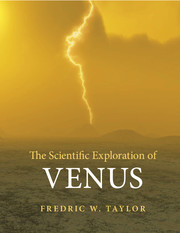Book contents
- Frontmatter
- Contents
- Overview
- Prologue
- A note on scientific units
- Acknowledgements
- Part I Views of Venus, from the beginning to the present day
- Chapter 1 The dawn of Venus exploration
- Chapter 2 Mariner and Venera
- Chapter 3 Pioneer Venus and Vega
- Chapter 4 Images of the surface
- Chapter 5 The forgotten world
- Chapter 6 Earth-based astronomy delivers a breakthrough
- Chapter 7 Can’t stop now
- Chapter 8 Europe and Japan Join In
- Part II The motivation to continue the quest
- Part III Plans and visions for the future
- Epilogue
- References and acknowledgements
- Appendix A Chronology of space missions to Venus
- Appendix B Data about Venus
- Index
- Plate section
Chapter 3 - Pioneer Venus and Vega
orbiters, balloons and multiprobes
from Part I - Views of Venus, from the beginning to the present day
Published online by Cambridge University Press: 05 September 2014
- Frontmatter
- Contents
- Overview
- Prologue
- A note on scientific units
- Acknowledgements
- Part I Views of Venus, from the beginning to the present day
- Chapter 1 The dawn of Venus exploration
- Chapter 2 Mariner and Venera
- Chapter 3 Pioneer Venus and Vega
- Chapter 4 Images of the surface
- Chapter 5 The forgotten world
- Chapter 6 Earth-based astronomy delivers a breakthrough
- Chapter 7 Can’t stop now
- Chapter 8 Europe and Japan Join In
- Part II The motivation to continue the quest
- Part III Plans and visions for the future
- Epilogue
- References and acknowledgements
- Appendix A Chronology of space missions to Venus
- Appendix B Data about Venus
- Index
- Plate section
Summary
The main achievement of the Mariner flybys and the Venera landings that took place between 1963 and 1983 was to show us the general nature of the Venus atmosphere and surface for the first time. Like all good experiments, they posed almost as many new questions as they answered. They therefore stoked controversy when it came to the interpretation of what clearly are very complicated, time-dependent phenomena, such as global circulation and weather in the atmosphere, and erosion and volcanism on the surface.
Spacecraft that fly quickly past the planet, and probes that descend rapidly through the atmosphere to die soon after on the surface, are the simplest missions to implement and are great for an initial exploration. However, to really understand what is going on, on a complex world, better coverage in space and time is needed than is obtained by a few scans across the planet or one vertical profile in the atmosphere. The second phase of Venus exploration would therefore require coordinated measurements from planet-circling orbiters for mapping and monitoring of the global atmosphere and surface, and of the near-space environment filled with neutral and charged particles and magnetic and electric fields. Ideally, these would be complemented by large numbers of simultaneous probes at different longitudes and times of day and night.
- Type
- Chapter
- Information
- The Scientific Exploration of Venus , pp. 32 - 47Publisher: Cambridge University PressPrint publication year: 2014



